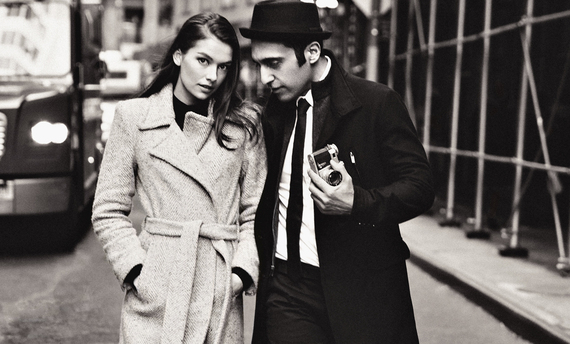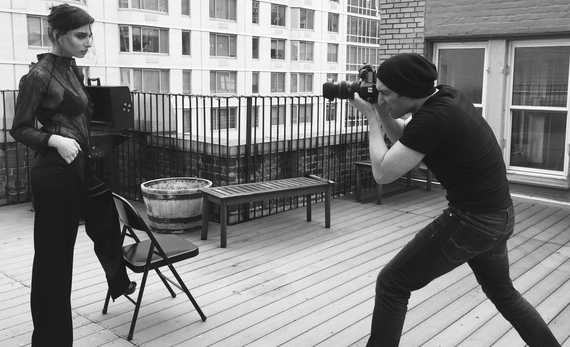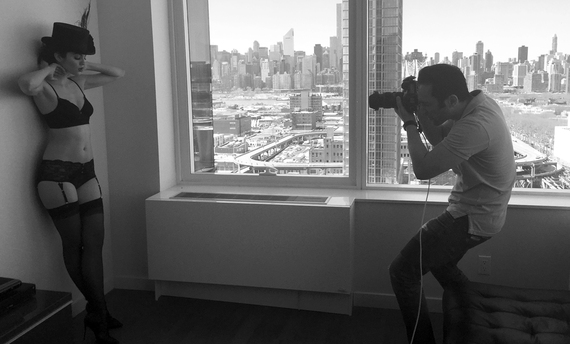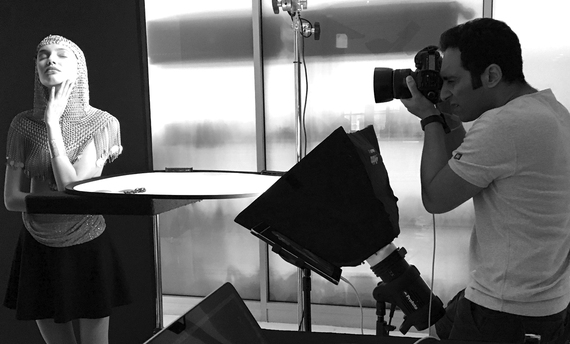
An Insight into Fashion Photography in Iran: Crackdown at Home, Competition Abroad
Photo from Kourosh Sotoodeh
Originally Posted On: https://www.huffpost.com/entry/an-insight-into-fashion-p_b_13236482
Had fashion photographer Kourosh Sotoodeh pursued his dream profession in his home country of Iran, he probably would have been arrested one day during a crackdown on the growing fashion industry by the country’s security apparatus–a crackdown which, over the past year, has prompted the authorities to label people like Kourosh “itinerant photographers who lure girls.” Since last January fashion photographers have been arrested in droves, along with fashion models and those involved in modelling agencies.
Since leaving the Islamic Republic to work for a Dubai-based agency in 2009–the year the Iranian government came down hard on protesters disputing Mahmoud Ahmadinejad’s re-election as president–he hasn’t looked back. Koroush has since relocated to New York City, where freedom of expression is as much a reality as rampant competition. “The subjects in my photography are people, therefore it is natural for me to want to go somewhere where people have more freedom with their clothes, conduct, and social acts,” Koroush tells me during a shoot at a Manhattan-based studio. In Iran, Koroush would have risked imprisonment or worse if he were to publish the photographs he took–of a partially-clothed female model–the day I interviewed him.
Trying to make it in the world’s most competitive fashion locale isn’t easy for anyone. Still, the 38-year-old has landed gigs with inCOVER magazine and Harper’s Bazaar, and seems completely at home. “As one of my favorite New Yorkers, [comedian] Louis C. K., said, I constantly throw away my best works and start all over again to create better works,” he tells me as he changes a lens. “I believe in that.”
As I caught up with Kourosh during one of his shoots, we delved into the problems and opportunities in Iran’s fashion industry, and how his career has taken off in the world’s fashion capital of New York City.
Omid Memarian (OM): When did you start your photography career? When did you leave Iran and why?
Koroush Sotoudeh (KS): I was interested in illustration from a very young age, but I started professional photography in March 1999. I was studying industrial design and naturally I spent most of my time at the Arts University where I learned more about photography and could see, enjoy and practice it. By “professional photography,” I mean the time I started earning a living through photography. It’s quite clear that back then I had a totally different concept and understanding of photography, compared to what I know now. Both my customers and I understood so little about it, so we thought we were doing fashion photography, but maybe it would be more accurate to say that I was engaged in some type of unusual portrait photography of subjects who liked to see themselves through my lens. Gradually, I gathered more experience and knowledge about the profession. After a modeling agency offered me a job in the field of fashion photography in 2009, I swiftly accepted the job and moved to Dubai.
OM: What problems did you face as a fashion photographer in Iran?
KS: There are many competent and creative fashion designers and photographers in Iran, some of whom will go far in gaining widespread recognition. There is also a large group of Iranian youth who are interested in modeling and have the internationally accepted physical features needed for this profession. But for many reasons, including the Iranian laws and the Iranian market’s lack of contact with the international fashion scene, many of these talented people will have to be terribly lucky to find a chance to prosper in this field.
I can’t say whether fashion photography is allowed in Iran or not, because the law is silent on many different issues, and this leaves a lot of room for subjective interpretations. But I can say with certainty that there are no laws against taking photographs of people who are wearing beautiful clothes, therefore there shouldn’t be any problems. Or if there is a problem, I never saw any rules developed to tell me as a photographer what to do and what not to do in order to stay away from trouble. The silence of the law enables different organizations to act according to their own taste. Just like all the other artists in Iran who choose people as subjects, I had problems too, but my biggest problem was an occasional security threat to a profession based on arts and aesthetics–something I could never understand.
OM: What areas of fashion photography face the biggest problems in Iran? Have these problems led to some photographers giving up on their field?
KS: Generally, when men are subjects of fashion photography, there are fewer limitations, although we can’t say this is always the case. There are a lot of limitations for photographing women, some of which are based on laws, but laws do not set many of these limitations. I’m not talking about nude photography, which of course everyone knows is not allowed in Iran! But there is a lot of subjective interpretation and enforcement of limitations. These limitations are increased or decreased based on the views of the officials in charge of arts and culture. As a photographer, you never know which rules you have to follow in order to build a long-term plan of action for your professional development. It is natural to be fed up and to give up the profession altogether after a while.
OM: Do you know photographers or models in Iran who were forced to do other work because of the pressure the government exerted over them?
KS: Yes, I do. I know a lot of people who were very talented in their work, and after they were unable to pursue their field in Iran, they decided to emigrate, but the immigration wasn’t always a good decision for them. Sometimes they were unable to compete in the job market and ended up doing work other than photography. Their inability to compete was not necessarily a result of their lack of expertise, but due to the different language, their inability to relate to the new society’s social conditions, and the absence of any support. But the hardships of a life in diaspora should not cause disappointment and defeat.
OM: Why do you think the Iranian authorities are monitoring Iranian models and photographers and trying to prevent their work?
KS: I don’t believe there is total agreement between the government decision-makers in this or in similar areas. When the entire path of a profession is limited by subjective decisions, the atmosphere for growth in that profession shrinks, and as a photographer working in such an environment, you would feel at best just tolerated. If fashion photography in Iran were to move towards nude and erotic photography, it would have seriously violated the law and a crackdown would be expected, but I believe that even nudity has not been properly defined and there are no clear boundaries.
Are there any written procedures on how much of a woman’s hair can be shown in a photograph? Is it written anywhere that if a woman has plump red lips, she should not be the subject of a close-up shot? If I don’t know these boundaries, my job becomes very difficult. I believe even the authorities differently define these boundaries and they each have their own ideas about them. Ultimately, their biggest concern is if these activities violate Islamic culture. But the truth is that even in defining the boundaries of Islamic culture, there is no unified voice or understanding.
OM: Do you think the continuous crackdowns on Iranian models and photographers will keep them from pursuing their work there? Will they be pushed underground?
KS: No. The industry will never stop. Clothes are one of the basic needs of human beings, no matter where people live. The fashion and clothing industry is very active in Iran and is naturally in need of promotion and marketing. Therefore, fashion photography, with all its limitations, will continue to exist, because the thinking behind this creativity is unstoppable. The thought process cannot be stopped and it will eventually find a way to be expressed. I think this situation is temporary and when something truly exists, it will have to be accepted. I hope laws are developed to define the boundaries, so everyone knows what is legal and what is illegal. The fact is that so much has been pushed underground, that there is now a huge underground world, bigger than the world above ground! This is why I think the ban needs to be re-thought. Can a world that is so extensive be marginalized?
OM: What do you think would happen if security agents realized a photographer is doing nude photography?
KS: Again, this is where the outcome could be different due to the subjective nature of handling the issue. Like many other things that are considered a crime in Iran, you never know exactly what would happen if you pass this red light! Would you be fined $200, would you be imprisoned, or would you be deprived of your civil rights? I have no doubt that this type of photography is considered a crime, and all I can say is that you would have to be very fortunate to end the issue with a cash fine. When there are different types of pressure on ordinary photographers, I don’t even want to think about what would happen to someone who does erotic photography in Iran!
OM: Is it possible to earn a living as a full-time professional fashion photographer in Iran?
KS: If by “professional” you mean someone who makes a living this way, the answer is yes. If you go to Instagram right now and search for a few simple keywords, you would be able to find a lot of Iranian photographers and models in this field. As I said before, this chain certainly exists and is economically viable. But if the question is whether they have world-class quality or not, the answer is dependent on a lot of other factors. It depends, for example, on how well the artist can promote himself or herself. When everyone is trying to toe the line, so as not to cross the government red lines, they would undoubtedly have less publicity and this could lead to lower work quality and revenue for them.
OM: With the emergence and widespread popularity of Instagram, many photographers and models have started showing their work on social media networks and some have a million followers. How instrumental do you think social media has been in the popularity of this type of photography?
KS: Social media, and especially Instagram have been absolutely instrumental! I think that’s because Instagram communicates with image-seeking audiences and this brings people closer. Because social media is far-reaching, everyone has access to it and when a photographer uses this tool, through peer influence other colleagues and competitors also move to use that tool, and this is why a large group of Iranian photographers moved to Instagram, for example. Organizations that oversee internet access in Iran then scramble to find mechanisms for controlling these artists. But I believe that social media has catapulted people forward, and even if the censorship organizations are successful in pulling people back, the art of photography has been able to take a few steps forward in gaining new audiences.
OM: Did you or other Iranian photographers ever try to sell your photos to publications outside Iran? Or were you only thinking about the domestic market?
KS: I think if you have professional ambitions, no matter what the profession, you always think about finding the best market and environment for your work. If you were a programmer in South Asia, you would for sure dream about working in Silicon Valley someday. If you were an Iranian soccer player, it is natural that your big dream would be to play in Spain’s La Liga. For me, the dream was to go wherever I could become a better and more experienced photographer. This is why I went to Dubai and now I am in the La Liga of photography in New York! As a photographer inside Iran, you may be able to send your photographs abroad, but the photos would have to be wildlife photography or social photography. The areas in which I was active hardly allowed me to be connected to the professional life outside Iran. This is why I had to move, so that I could strengthen my professional relationship with the international market. The subjects in my photography are people; therefore it is natural for me to want to go somewhere where people have more freedom with their clothes, conduct, and social acts.
OM: What kind of things can you do in New York that are not possible in Iran?
KS: I always considered myself a citizen of the world, not of a particular country. I believe that I have to live where the general public’s values are closer to mine. This does not necessarily mean that where I am is better or worse; it just suits me more. When a large part of my identity is comprised of being a photographer and my desire to illustrate, it’s not at all strange that I would feel more comfortable here professionally and personally. The most important thing for me is that this city’s tempo and dynamics totally match my energy level and every morning when I wake up, I’m in a race with my city, and I love this feeling a lot. Before I forget, of course, I should add that in New York no one investigates and measures the hair and figures of my models with a ruler and a magnifying glass!
OM: What would you like to accomplish in New York?
KS: I definitely have some big dreams. I would like to be known as a New York photographer whose work has its own character and signature, and to show my view behind the camera to those in the fashion industry here. I hope next time we meet, my pictures do all the talking!




